Muchos blogueros comienzan su andadura en Blogger porque es una plataforma gratuita y sencilla. Sin embargo, a medida que tu blog crece, es posible que empieces a sentirte restringido por sus características limitadas.
Pasarse a WordPress puede abrir un mundo de posibilidades gracias a sus amplias capacidades. Pero hay una preocupación común acerca de este cambio: la posible pérdida de posiciones en Google.
Este artículo le guiará a través del proceso de transición de Blogger a WordPress. Nos centraremos en cómo hacerlo correctamente, asegurándonos de que mantienes intactas tus valiosas posiciones en Google.
Nuestro objetivo es ayudarle a actualizar su plataforma de blog sin sacrificar los esfuerzos de SEO que ya ha realizado en su sitio.
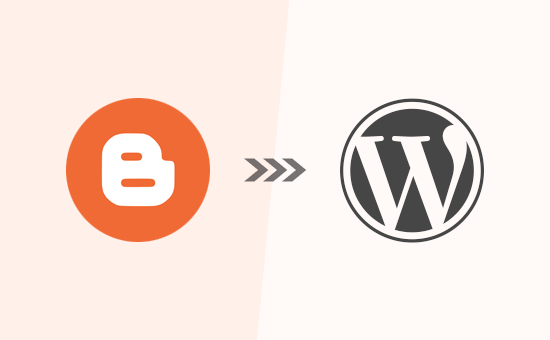
¿Por qué pasar de Blogger a WordPress?
Blogger es una popular plataforma de blogs creada por Google. Permite a cualquiera crear un blog gratuito utilizando su cuenta de Google.
Sin embargo, muchos principiantes pronto se dan cuenta de que hay muchas limitaciones en lo que pueden hacer con su blog gratuito de Blogger.
WordPress, en cambio, te da la propiedad completa de tu sitio web. También te permite añadir las características necesarias para hacer crecer tu blog y monetizar tu contenido. Además, puedes realizar todas las optimizaciones SEO necesarias para mejorar tu posicionamiento. Hemos creado una comparación detallada entre WordPress y Blogger.
Es importante tener en cuenta que cuando hablamos de WordPress, estamos hablando de WordPress.org autoalojado, que NO debe confundirse con WordPress.com, que es una solución de alojamiento que tiene sus propias limitaciones. Para más detalles, consulte nuestro artículo sobre la diferencia entre WordPress.com y WordPress.org.
WordPress.org es la popular plataforma “WordPress”, de la que probablemente haya oído hablar porque alimenta el 43% de todos los sitios web de Internet.
Dicho esto, vamos a ver cómo pasar correctamente de Blogger a WordPress sin perder la posición en las búsquedas de Google ni el tráfico del sitio web.
Estos son los pasos que seguiremos para pasar de Blogger a WordPress:
¿Preparados? Primeros pasos.
Tutorial en vídeo
Si no desea ver el tutorial en vídeo, puede seguir leyendo la versión en texto que figura a continuación.
Paso 1: Registrarse en el alojamiento de WordPress
Para empezar con WordPress, necesitará un nombre de dominio y alojamiento web.
A modo de recordatorio, el nombre de dominio es la dirección de tu sitio web que la gente teclea para llegar a tu blog, y el alojamiento web es donde se almacenan los archivos de tu sitio web. Ambos son IMPRESCINDIBLES para crear cualquier tipo de blog o sitio web.
Dicho esto, recomendamos utilizar Bluehost. Es una de las empresas de alojamiento más grandes del mundo y es un socio de alojamiento de WordPress recomendado oficialmente.
Debido a que WPBeginner es el mayor sitio de recursos de WordPress, han acordado ofrecer a nuestros lectores un nombre de dominio gratis y un 60% de descuento en alojamiento. Básicamente, puedes empezar por solo 1,99 $ al mes.
Si, por alguna razón, usted prefiere ir con una alternativa Bluehost, entonces le recomendamos que utilice ya sea SiteGround o Hostinger porque ambos son excelentes soluciones.
Una vez que se haya suscrito al plan de alojamiento de WordPress y haya establecido su nombre de dominio, puede continuar con el paso de instalación de WordPress.
Si te registras en Bluehost utilizando nuestro enlace anterior, ellos te instalarán WordPress automáticamente.
Si ha utilizado un proveedor de alojamiento de WordPress diferente, deberá instalar WordPress siguiendo nuestra guía definitiva sobre cómo instalar WordPress.
Una vez instalado WordPress, es hora de trasladar su contenido de Blogger a WordPress.
Oferta adicional gratuita: Como muchos de vosotros nos lo habéis pedido, ahora ofrecemos un servicio gratuito de migración de Blogger a WordPress como parte de nuestro servicio gratuito de creación de blogs en WordPress. Esto significa que uno de los miembros de nuestro equipo de expertos hará toda la migración por ti (100% gratis). Sí, puedes cambiar literalmente de Blogger a WordPress sin ningún riesgo.
Nota: Nuestro servicio gratuito de migración de blogger es para blogs pequeños que tengan menos de 1000 entradas. Podemos ofrecer un servicio de migración para sitios de blogger más grandes, pero será un servicio de pago.
Sin embargo, si te gusta aprender y hacer las cosas por ti mismo, puedes seguir nuestro tutorial paso a paso.
Paso 1: Exporta tu blog de Blogger
Lo primero que tienes que hacer es exportar el contenido de tu blog de Blogger.
Para ello, visite el sitio web de Blogger y acceda al tablero de su cuenta.
Después, ve a la página de ajustes. Desplázate hasta la sección “Gestionar blog” y haz clic en el botón “Copia de seguridad del contenido”.
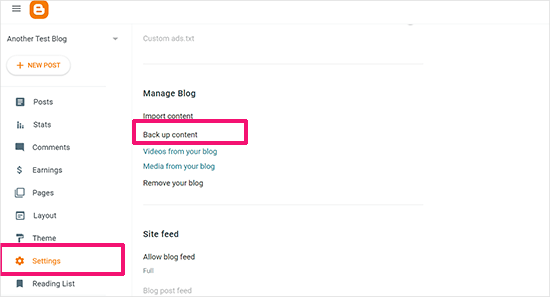
Aparecerá un mensaje / ventana emergente mostrando qué se incluye exactamente en la copia de seguridad de Blogger.
Debe hacer clic en el botón “Descargar” para continuar.
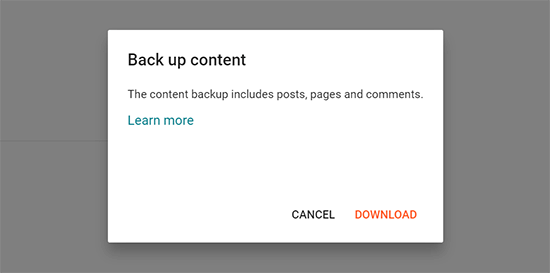
El contenido de tu blog de Blogger se descargará en tu ordenador en un archivo XML.
Una vez finalizada la descarga, es hora de importar el contenido de Blogger a tu sitio de WordPress.
Paso 2: Importar Blogger a WordPress
Para empezar a importar tu sitio de Blogger a WordPress, accede a tu área de administrador de WordPress y visita Herramientas ” Importar.
En la página de importación, haz clic en el enlace “Instalar ahora” que aparece debajo de Blogger.
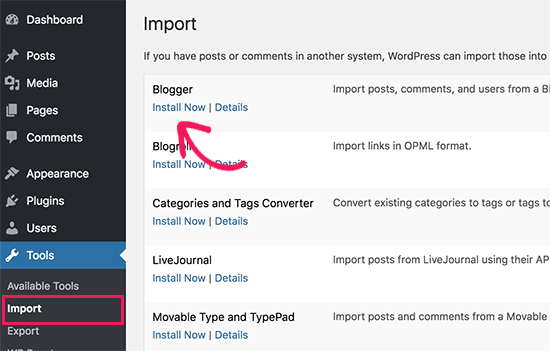
WordPress descargará e instalará el plugin Blogger Importer.
Cuando termine de instalarse, haga clic en el enlace “Ejecutar importador” para continuar.
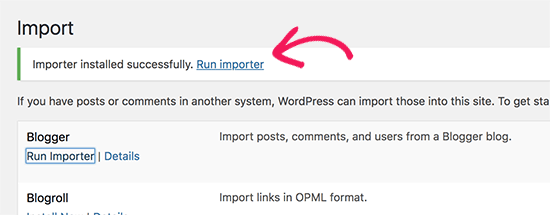
WordPress le pedirá que suba el archivo XML en la pantalla Importar Blogger. Este es el archivo que descargaste en el Paso 1.
Simplemente haga clic en el botón “Elegir archivo” y suba el archivo XML que descargó anteriormente.
A continuación, haga clic en el botón “Subir archivo e importar” para continuar.
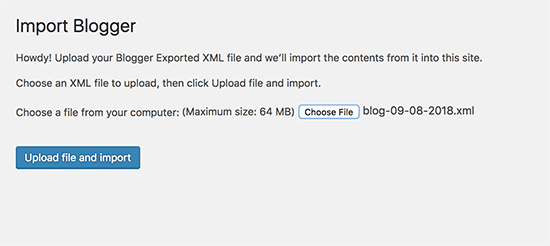
WordPress subirá el archivo de importación. Si el archivo de importación es demasiado grande, es posible que aparezca un mensaje de error.
En este caso, deberá aumentar el límite máximo de subida de archivos. Si el archivo es pequeño, no se producirá ningún error.
A continuación, se te pedirá que asignes entradas a un autor. Si tienes varios autores en tu blog de Blogger, puedes crear una nueva cuenta de usuario para cada autor. También puedes asignar estas entradas a autores existentes en tu sitio web WordPress.
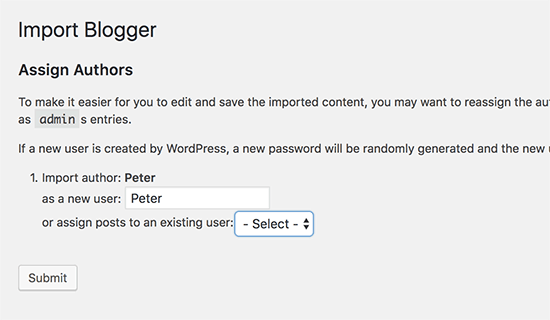
Después de hacer su selección, haga clic en el botón “Enviar” para continuar.
WordPress importará todo el contenido del archivo de exportación de Blogger a tu sitio WordPress. Puedes ver el contenido visitando la página Entradas ” Todas las entradas.
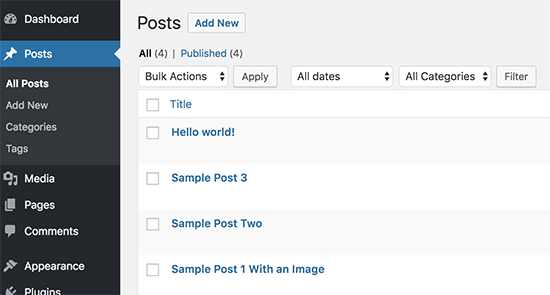
Paso 3: Establecer Enlaces permanentes
Enlaces permanentes es el término utilizado para la estructura de URL de páginas individuales. WordPress viene con una característica que le permite establecer una estructura de URL SEO-friendly.
Como estás importando contenido de Blogger, necesitas que la estructura de URL sea lo más parecida posible a la de tu antiguo sitio de Blogger.
Para establecer enlaces permanentes, debe ir a Ajustes ” Enlaces permanentes en su escritorio de WordPress y elegir la opción “Estructura personalizada”.
A continuación, deberá añadir el siguiente texto en la casilla situada junto al campo de estructura personalizada:
/%year%/%monthnum%/%postname%.html
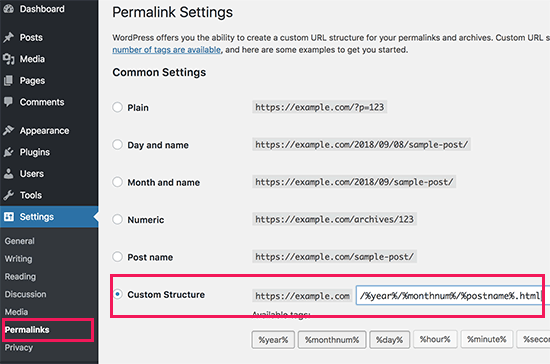
Esta estructura de enlaces permanentes hace que las URL de las entradas de tu blog sean similares a las URL de tu antiguo blog de Blogger.
Sin embargo, a veces la URL de la entrada de tu blog, también conocida como slug en WordPress, no coincide con los slugs utilizados por Blogger.
Para corregirlo, tendrá que crear y ejecutar un pequeño fragmento de código.
Recomendamos añadir este código PHP usando el plugin WPCode. Es la forma más segura de añadir código personalizado a su sitio web WordPress. Para más detalles, consulte nuestra guía sobre cómo copiar y pegar fragmentos de código en WordPress.
add_action( 'init', 'wpb_update_slug' );
function wpb_update_slug() {
global $wpdb;
$result = $wpdb->get_results("SELECT post_id, meta_value FROM $wpdb->postmeta WHERE meta_key = 'blogger_permalink' ");
$wpdb->print_error();
foreach ($result as $row){
$slug = explode("/",$row->meta_value);
$slug = explode(".",$slug[3]);
$wpdb->query("UPDATE $wpdb->posts SET post_name ='$slug[0]' WHERE ID = '$row->post_id' ");
}
echo "DONE";
}
Después de guardar el código, sólo tiene que visitar cualquier página de su sitio WordPress para activar este script.
Importante: Después de que el script se haya ejecutado, no olvides desactivarlo o borrarlo de tu biblioteca WPCode porque solo necesita ejecutarse una vez.
Oferta gratuita de bonificación: ¿No quiere lidiar con códigos? Lo tenemos cubierto. Como muchos de vosotros nos lo habéis pedido, ahora ofrecemos un servicio gratuito de migración de Blogger a WordPress como parte de nuestro servicio gratuito de creación de blogs en WordPress.
Esto significa que uno de los miembros de nuestro equipo de expertos realizará toda la migración por ti (100% gratis). Sí, puedes cambiar literalmente de Blogger a WordPress sin ningún riesgo.
Paso 4: Establecer las redirecciones de Blogger a WordPress
El paso más importante a la hora de trasladar un sitio web es establecer la redirección adecuada para no perder tráfico ni posiciones SEO. Puedes consultar nuestra lista de comprobación definitiva para la migración SEO de WordPress para obtener más detalles.
Nota: Si tu blog de Blogger tiene su propio dominio personalizado en lugar de blogspot.com, puede que tengas que apuntar los servidores de nombres de tu dominio a tu proveedor de alojamiento. Para obtener instrucciones, sigue nuestro tutorial sobre cómo cambiar el dominio personalizado de blogger a WordPress.
La parte crucial de la redirección es garantizar que sus usuarios aterricen en la misma página del nuevo dominio a la que intentaban acceder en el sitio antiguo.
Al mismo tiempo, también debe asegurarse de que los motores de búsqueda entienden que su sitio web se ha trasladado a esta nueva ubicación.
Para ello, debes instalar y activar el plugin Blogger to WordPress Redirection. Para más detalles, consulta nuestra guía paso a paso sobre cómo instalar un plugin de WordPress.
Una vez activado, debe visitar la página Herramientas ” Redirección de Blogger a WordPress y hacer clic en el botón “Iniciar configuración”.
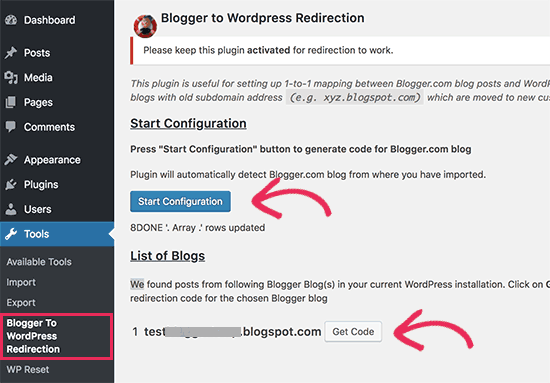
El plugin detectará ahora la URL de tu blog de Blogger y te mostrará la opción de obtener un código de redirección. Sigue adelante y haz clic en el botón ‘Obtener código’ al lado de tu URL de Blogger.
Ahora generará un fragmento de código que necesitas para redirigir correctamente a los usuarios de tu antiguo blog de Blogger a tu nuevo sitio de WordPress.
A continuación, tienes que acceder a tu Escritorio de Blogger e ir a la página “Temas”. Haz clic en la flecha desplegable del botón “Personalizar” situado junto a tu tema y, a continuación, selecciona la opción “Editar HTML”.
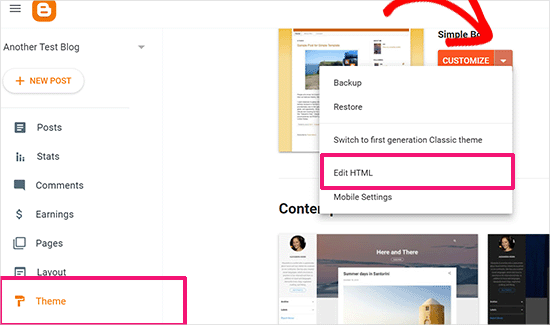
Blogger mostrará ahora el código HTML personalizado para la plantilla de tu tema. Si has personalizado el tema de Blogger, puedes copiar el código y guardarlo en tu ordenador como copia de seguridad.
Si no, puedes borrarlo todo. A continuación, copia el código que muestra el plugin en tu sitio de WordPress y pégalo en el editor de temas de Blogger.
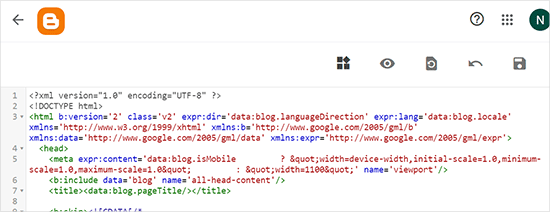
No olvides hacer clic en el botón “Guardar tema” para guardar los cambios.
A continuación, tenemos que establecer las redirecciones para los usuarios móviles.
Tienes que volver a la página Temas del Escritorio de tu blog de Blogger. Esta vez tienes que hacer clic en el botón de engranaje debajo de la vista previa móvil de tu blog.
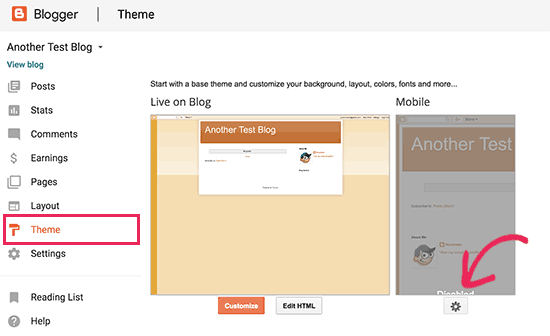
Aparecerá una ventana emergente en la que deberás seleccionar la opción “No. Mostrar tema de escritorio en dispositivos móviles”.
A continuación, haz clic en el botón “Guardar”.
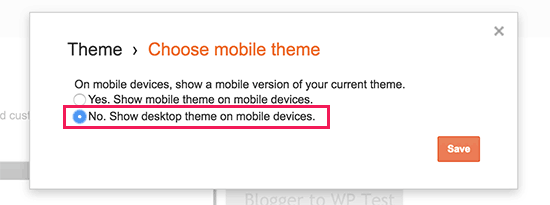
Eso es todo, tu blog de Blogger ahora redirigirá a todos los visitantes de tu blog a tu nuevo blog de WordPress.
También puedes utilizar All in One SEO (AIOSEO) para redirigir entradas y páginas de Blogger a WordPress. El plugin ofrece una potente característica de gestión de redireccionamientos que te permite establecer redireccionamientos completos del sitio a tu nuevo sitio.
Además, puede activar el seguimiento de errores 404 y detectar cualquier enlace roto que pueda producirse al trasladar su sitio a WordPress. Esto ayudará a mejorar la experiencia del usuario y no perderás posiciones en el ranking de palabras clave.
Paso 5: Trasladar otros contenidos de Blogger a WordPress
En este paso, trasladaremos el contenido restante del antiguo blog de Blogger a tu nuevo blog de WordPress. Esto puede requerir algo de trabajo manual, dependiendo de los ajustes / contenido de su blog.
1. Trasladar páginas de Blogger a WordPress
La herramienta de importación de Blogger de WordPress solo importa entradas de Blogger e ignora las páginas.
Para trasladar tus páginas a WordPress, tendrás que editar cada página en tu blog de Blogger, copiar su contenido y, a continuación, crear manualmente una página en WordPress.
Para saber más acerca de las páginas, consulte nuestro artículo sobre la diferencia entre entradas y páginas en WordPress.
Ahora, te encontrarás con otro problema / conflicto / incidencia. Las páginas de Blogger tienen URL con este aspecto:
http://example.blogspot.com/p/about-us.html
La URL de su página de WordPress tendrá este aspecto:
http://example.com/about-us
Para corregir esto, necesitará utilizar el plugin All in One SEO (AIOSEO). Para obtener instrucciones, consulta nuestra guía para principiantes sobre cómo crear redireccionamientos en WordPress.
2. Widgets
Al igual que Blogger, algunos temas de WordPress también utilizan widgets para añadir contenido a la barra lateral de tu blog.
Para añadir widgets, debe visitar la página Apariencia ” Widgets en su escritorio de WordPress y simplemente arrastrar y soltar los widgets en las barras laterales. Para obtener instrucciones detalladas, consulte nuestra guía sobre cómo añadir y utilizar widgets en WordPress.
Si estás buscando un widget específico que no ves en WordPress por defecto, entonces es probable que necesites un plugin de WordPress. Puedes buscar en la categoría de mejores plugins de WordPress de WPBeginner para encontrar la funcionalidad que buscas.
3. Feeds RSS
Los motores de búsqueda y los usuarios que se suscriban a las entradas de su blog a través de feeds RSS podrán seguir encontrándolo. Sin embargo, no recibirán ningún contenido nuevo.
Para corregirlo, visita la página de ajustes de tu cuenta de Blogger. A continuación, desplázate hasta la sección “Site feed” y haz clic en “Post feed redirect URL”.
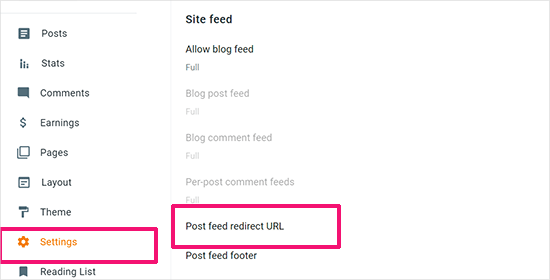
Aparecerá una ventana emergente en la que deberá añadir la URL del feed RSS de su sitio web WordPress.
La URL de su feed de WordPress tendrá este aspecto:
http://example.com/feed
No olvide sustituir ejemplo.com por su propio nombre de dominio.
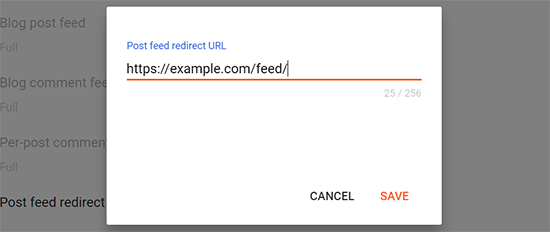
Haga clic en el botón “Guardar” para añadir la URL y establecer los ajustes.
Paso 6. Cosas que hacer después de migrar de Blogger a WordPress
Ahora que has trasladado correctamente tu blog de Blogger a WordPress, veamos qué más puedes hacer para mejorar tu blog.
Hemos creado una lista de las cosas más importantes que debe hacer después de instalar WordPress.
WordPress es bastante fácil de usar. Sin embargo, de vez en cuando descubrirás cosas nuevas con las que necesitarás ayuda. Aquí es donde WPBeginner entra en juego.
WPBeginner es el sitio de recursos gratuitos de WordPress más grande del mundo. Publicamos regularmente tutoriales y guías escritas específicamente para blogueros y pequeñas empresas.
Estos son algunos de los recursos útiles que encontrará en WPBeginner (todos ellos son gratuitos):
- WPBeginner Blog – El lugar central para todos nuestros tutoriales y guías de WordPress.
- Diccionario WPBeginner – Nuestro glosario de WordPress es el mejor lugar para familiarizarse con la jerga de WordPress.
- WPBeginner Videos – Los nuevos usuarios de WordPress pueden empezar con estos videos paso a paso para dominar WordPress.
- WPBeginner en YouTube – ¿Necesitas más instrucciones en vídeo? Suscríbete a nuestro canal de YouTube con más de 291.000 suscriptores y más de 50 millones de visitas.
- WPBeginner Blueprint – Marcar / comprobar los plugins, herramientas y servicios que utilizamos en WPBeginner.
- WPBeginner Deals – Descuentos exclusivos en productos y servicios de WordPress para usuarios de WPBeginner.
Esperamos que este artículo te haya ayudado a cambiar de Blogger a WordPress sin afectar a tu posicionamiento en Google. También puedes consultar nuestra guía sobre qué plan de WordPress deberías utilizar o los mitos más comunes sobre WordPress desmentidos.
If you liked this article, then please subscribe to our YouTube Channel for WordPress video tutorials. You can also find us on Twitter and Facebook.




Mini
This useful even for moving free blog on blogspot to free blog on wordpress?
And will it transfer previously received comments too?
Katheriine
I have a problem with all of my pinterest pins stopping at a blogger page saying “this blog is no longer hosted by blogger do you wish to be redirected?” and you have to choose yes or no and obviously people usually just exit out or hit no so it’s killing my page views. Any help??
Susann
I don’t have the export blog (or import) button on my blogg. Only the Delete button. Did they take this away, how can I export my blog now? Or do I need to change anything somewhere else to get it to show up?
Eli
Hi, I don’t can’t use permalinks with /month/day, i need to use /blog-post-title.
is there a way to modify the php code, to get a proper redirect?
WAHEED HABIB
Dear Author, thank u so much for such a great help in transferring blogger data to wordpress theme. But redirection woud;nt work for me rather i use simple Blogger to WordPress Redirection plugin a very simple and easy to use tool i just love it. I have redirect my blogger site to WordPress.
Mallory
Hi! Thank you so much for this helpful guide!!
I’ve done everything as you explained and redirection works but I get this message on top of my wordpress: Notice: Undefined index: blogger in /var/www/vhost/example/home/html/wp-content/themes/betheme-child/functions.php on line 94
I therefore went and checked line 94 and this is the one: $blogger = $wp_query->query_vars[‘blogger’];
would you be able to help me?
Thank you so much
Patricia
Hi, currently trying to follow your instructions but I keep getting this message when I try to save the blogger redirection code in reference to the blog page title line.
“Error parsing XML, line 3, column 9: The content of elements must consist of well-formed character data or markup.”
Please help?
JC
Glad i found this. I’ve been so afraid to move my blog from blogger to W/P. One question: Do my followers on blogger also go with me?
Also, is there a way (don’t know what it’s called) to let those that come to your blogger site know that you’ve moved to W/P?
WPBeginner Support
If by followers you mean those who used Google ID to follow your blogger blog, then no.
Yes, using this method, people arriving at your blogger site through other sources will be properly redirected to your new site.
Admin
Lindsey
So helpful. However, when I refresh after all the steps, I get the 2nd code we pasted showing at the top. Am I missing something? It is even showing in my WP Admin dashboard!!
WPBeginner Support
It seems you pasted the code after a closing ?> php tag. You can paste the code again before the closing php tag or add this tag at the beginning of the code
<?phpAdmin
Katelyn
I am having the hardest time converting from BlogSpot to Word Press. For some reason I don’t know if it’s the browser I’m using or what but when I go to Settings –> Other —> to import and backup or backup content (those are the only two options it give me) I don’t have an export blog option. I’m getting ready to just freakin pay someone to do it!
Huda
What about the design theme? can I change it to wordpress theme?
Sy Abuzar
Hello. Brother.
This is Very Useful Article Amazing and Mind Blowing Guidelines Step by Step, I like It Thanks a lot,
Have a Nice Day Ahead
Febriyan
I had tried all the steps there and if I opened my blogspot blog on my computer, it worked just fine. It redirected automatically to the new domain on wordpress. But if I use my phone or asked my friend to access the blogspot, it didn’t do anything. No redirection at all.
Can you help me on this?
my blogspot is
Erin
Thank you for your post, super easy to follow and felt confident importing my blog. Though alas and alack I had trouble with the images, they didn’t import. I then followed your extra assistance for that scenario but whilst some imported to media library, some didn’t, and none are showing as featured images.
Any tips would be greatly appreciated.
collins
Thanks it helped,,Please i’ll love to talk 2 privately here is my mail address.
WPBeginner Support
Please use our contact page to send us private mail.
Admin
Mercedes
Thank you! This was super helpful.
Having a little trouble with the second code though. I have no idea how to even access the file I need to paste the code into?
WPBeginner Support
It goes in your theme’s functions.php file. Go to Appearance page in your WordPress admin area, and note the name of your active theme. Connect to your website using an FTP client, go to /wp-content/themes/your-active-theme-folder/ and there you will find functions.php file. Download it to your computer and open it with a plain text editor like Notepad. Paste the code at the end of this file. Save the file and upload it back to your theme folder using FTP.
Admin
Biz Harris
oh gosh, this was super helpful, but ONE note… maybe in the section about entirely changing the blogger code, be SUPER specific that you should change every “http://example.com” to your blog address AND that “www” beforehand isn’t necessary. I tried several iterations before I got this to work for me (and had a couple of panic attacks in the meantime.) anyway, thanks again from this VERY novie workpress beginner!
anyway, thanks again from this VERY novie workpress beginner!
Nicole
This was such a helpful blog post. So many people offer too much information or not enough, but you walked me straight through it! Thank you! I used Thad’s advice to get the mobile views to redirect. That worked.
My only problem now is that I can’t get my “pages” to redirect. They didn’t export/import, so I created new pages, with new names. Can I redirect these 15 pages manually in some way? or at least have a user redirected to my new home pages? Right now they are getting the message that “page you were looking for…does not exist.”
Thank you again! You have been so helpful!
Jwphoto
I’m having this same issue. When I google my blog name these old blogger pages (these were my menu items, not posts) show up. I can’t find a way in blogger to change the url. Is there a way to redirect these individual pages or change their url? Deleting these blogger pages would be bad for SEO, right?
Pascale
Hello, can you confirm where we should paste the 2nd code in function.php? I have read the Beginner’s guide to pasting snippets from the web into wordpress and it is still not clear.
Thank you so much for your help!
WPBeginner Support
It needs to go in your WordPress theme’s functions.php file. You can paste it at the very end of that file.
Admin
Vinayak SP
Above code not worked fully until you do this :
Configure Permalinks on New WordPress
From WordPress Dashboard, go to Settings -> Permalinks and select Custom Structure option and paste the following value next to it and save changes.
/%year%/%monthnum%/%postname%.html
Jas
Hello Syed,
1.
a) I notice in this article you specify the Permalink Settings as follows.
“choose Month and Name”
b) However in your How to “Move Custom Domain Blogger Blog to WordPress” your specify Permalink settings differently in custom format.
“/%year%/%monthnum%/%postname%.html”
2. I did not see the second article until I had already done the migration. I used a) above, then after the migration was complete, I changed it to b) above.
Why the difference between the two? Did I create a problem by beginning with a) then changing to b)? The Google search links seem to link correctly from old posts to new. Is there another factor I am not considering?
Thanks for your time,
Jas
urgent, priority
Tawnya
I have a question on where you copy the 2nd code on redirecting to wordpress do I just copy the code at the bottom of the functions.php file or is there a specific place on that page to copy the code??
Tawnya
I understand all of this except where do I paste the code in wordpress when you say this?
***However, you still need to setup redirection on your WordPress site so that users are redirected to the proper posts.
You need to copy and paste the following code in your WordPress theme’s functions.php file***
Do I just copy that code you provided at the bottom of this section on my wordpress or do I need to make sure it goes in a specific spot??
I hope that makes sense. Thanks for this tutorial
WPBeginner Support
Yes you need to copy the code in the bottom section and then paste it in your WordPress theme’s functions file. Check out beginners guide to pasting snippets from the web into WordPress
Admin
Tawnya
Where in the functions.php do I copy the second code though? I am still confused where that code is supposed to go?
Zara
I can’t find tools or anything in wordpress. Did they update it?
WPBeginner Support
Nope.
Admin
Amy Hunt
I can’t find tools in WP either..Publish, Personalise,Configure those are the only categories?
Lyssa
Thank you for this helping tutorial
i have been read almost full of your blog it’s very informative and helpful
WPBeginner Support
Thanks for the kind words.
Admin
Carla Mota
You are the best!! Thanks
Millo Magnocavallo
Add to previous comment …
I just looked at the source version of the text that’s been imported and in some cases the img tag is appearing like this:
for some reason it’s not printing out the src?
Paul Wentzell
This happens for me, also. I do see that the images for those posts downloaded to the site directory, but it’s curious why they were not inserted into the src of the post.
Millo
Hey! Thank you so much for a great tutorial / how-to. It worked really well, only that I’ve noticed that some images are not appearing in the imported blog posts. Do you have any idea why that might be?
Sharaj Khan
what about blogger to blogger ??????
Sam
easy, just backup template and then upload it on the other blog
Olsi
I followed this guide and it worked very well, but I did a redirect test and it says 302 Moved Temporarily and not 301 as it should be.
I`m I doing something wrong? Anybody else did a redirect test?
Paul
I’m also seeing a 302 from any redirect checker tool I am using. All links are indeed redirecting correctly, but 302 is making me uneasy.
Gianluca
Hi, is it possible to import only several posts from the older blog, instead the entire blog?
Thales
I found a work around…
I have replaced the code (line 11):
window.location.href=”http://example.com/?blogger=”
by the following 3 lines:
var str = “”;
var url_old = str.substr(7);
window.location.href=’http://pequenospelomundo.com.br/?blogger=’+url_old;
It works fine and seems that I have kept my google rankings.
Joel
I’m considering this option but am getting stuck on step #1. When I export an xml file from Blogger, the resultant file only includes 200 of my 1030 posts. Why? And what can I do to actually back up ALL of my blog.
Wordpresser
Do you still need to redirect the blogger blog to the wordpress domain if the URL structure including domain, date, article name and .html ending of the URL will all be exactly the same on WordPress as they are on Blogger?
Shelly
I have downloaded the blogger blog and am trying to import the file. It appears to be uploading but then I get the following error: Warning: Invalid argument supplied for foreach() in /home/content/p3pnexwpnas06_data02/87/2994987/html/wp-content/plugins/blogger-importer/blogger-importer.php on line 227
The blogger blog has almost 2,000 posts. Could the size be the problem? I’m afraid I am a complete newbie and am following directions step-by-step.
Kinshuk
Hi,
I am facing the similar issue to Shelly where I am getting following error:. I have around 2000 posts in blogger xml.
Regards.
Emilie
Thank you so much for such an informative and helpful video! I am totally a code newbie, but with your fantastic instructions, even I was able to get my blogger account to automatically send viewers over to my new domain. I only have one problem– and I think it has to do with the second set of code you had me post into the when the function.php file in wordpress. Rather than redirecting users to the specific article that they are attempting to reference in blogger, it just redirects to my entire, overall website. How can I fix it so that users who are clicking on old pinterest pins, etc, receive the recipe that they are looking for, rather than just a generic site where they have to search for the recipe they want? Thanks.
Fachreza
this is legal for blogger and wordpress ???
Michelle Dear
Yes. You own your data. You have the right to port it between tools.
Jericho
Thanks for this tutorial. I have a question, I am using custom domain in my blogger blog and this is the same domain I am going to use in WordPress. Do I have to disconnect the custom domain first and use the “blogspot.com” before heading to migration of my blog? If so, this will affect on my google rankings?
WPBeginner Support
Please see our guide How to move custom domain blogger blog to WordPress
Admin
Julia Taylor
Do you advise deleting the old blogger blog once the site is redirecting properly? Or should we wait for a certain period (if so, how long?)? Or is it best to leave it up for any reason?
WPBeginner Support
It is a free blog, why delete it if its not hurting your rankings? But if you must delete it, then we would recommend waiting for at least 6-12 months.
Admin
Julia Taylor
Well I guess I am not 100% confident we aren’t going to get hurt for duplicate content, since we are still seeing activity in the “Stats” tab. How do I test to make sure that is not going to happen?
Jason Booth
The 301 redirect and canonical tag should alleviate the fear about duplicate content but what I’ve found that this technique is not redirecting mobile traffic.
Mobile users are getting a different template on Blogger and not being redirected to the new site. I’ve been looking into it but have yet to find how to disable or change the template served to mobile devices.
Thales
I had the same issue (mobile users still accessing blogger). I have disabled mobile version in blogger and works fine.
Log in to blogger; go to template; click ‘update template’; on the top of the page you have the mobile preferences. Click and disable mobile version; then click back in ‘Revert to classic template’ – Done!
Julia Taylor
I am glad Jason pointed out the issue that mobile users are not being redirected. Can you guys please help us figure this out? I need the blog posts on mobile to also be redirecting to the new site, which they are not.
Julia Taylor
Oops, I missed the comment from Thales. Just did that, and it appears to be working. Thank you Thales!
Jason Booth
Thanks, Thales! Fixed it for me as well.
Julia Taylor
I followed all your instructions and everything seems to be working just fine, but we are still seeing some page views in the old Blogger site’s stats tab. Is it tracking the pages/posts that are redirecting to the new self-hosted WP site? Or is something not set correctly?
WPBeginner Support
Your blogger blog is not just visited by humans but also by many bots, crawlers, automated scrips, etc. Some of these bots may request a cached version of your blog this will generate a page view in Blogger’s stats. You can see the device information in your stats tab for that particular day.
Admin
Samantha
I’m trying to redirect my blog to my new wordpress site, but I’m turning all my blog posts into knowledge base articles.
How would I modify the code so that oldblog.blogspot.com/month/day/postname redirects to example.com/knowledgebase/postname
The “/knowledgebase” part is automatically added by the plugin I’m using and is not part of the permalinks structure.
WPBeginner Support
You can switch the post type to knowledgebase. We are not sure what kind of affect it will have on redirects. Its best if you test it on a local install with demo blogspot blog first.
Admin
Ketan
This was probably the easiest explanation of migrating from blogger to WP that I found till date. Thanks for posting. The redirect bit – that is something to do carefully.
Kim Brookes
I wrote a bit ago. You should probably ignore what I wrote because for some reason now it’s working. It’s either working now because I copied the snippet for the blogger template again, and changed the “example.com”s again. Or, because the links embedded on my WP site posts (that were ported from blogger) still have the blogger URLs, which WP interprets by substituting .blogger.com with my.new.url, which goes 404 on WP.
That is, in case it’s helpful, the post that was on blogger, now WP:
included a link in the text to
which somehow in the migration, or me doing something wrong, got changed into
and that’s a URL that doesn’t exist (WP with a .html instead of /)
So, mostly thanks for your awesome site. And ignore my previous comment.
-Kim
WPBeginner Support
We are glad you successfully migrated your website.
Admin
Kim Brookes
Awesome site you have here! I’ve used all sorts of the articles.
I’ve followed all of the instructions on this “how to switch” page. Most of it is working, but the old links on Blogspot aren’t redirecting to my new domain. They’re going to a 404. This is because the old blogspot URLs end in .html, and the new WordPress URLs end with the post_title/
as though it’s a directory instead of old-fashioned .html file. I think the issue is with the WP function code, but I don’t know the coding well enough to guess at how to make WP redirect to a (delete the slash, add “.html”) URL.
Nor do I know how to add the coding to the WP permalink page. I don’t want to mess with this, though because I don’t want “.html” added to all of my new posts. For now, the only think I can think to do is to change the permalink individually on all of my migrated-to-WP blogspot posts. Yuck.
Thanks for any help you can provide.
Julia Taylor
Thank you SO MUCH for this post…it really helped me! I do have a question. Is it possible to redirect the main blog address to a page on the site? The reason I am asking is because the new blog is just part of site, and redirecting blog reader to the homepage might be confusing. So can can I redirect example.blogspot.com to http://www.example.com/blog/, instead of http://www.example.com? I am a little nervous to go messing with your beautiful redirect code as I do not want to mess it up! Thanks so much!!!
WPBeginner Support
Yes, you can do that.
Admin
Christene
Before I begin doing this, I need to know something: Once all the content on my Blogger site is imported to WordPress…will all the imported posts automatically go live? Or will they import as a draft status? I wouldn’t want them to go live yet. The reason for the migration would be a stand-by thing, in case Blogger deletes my blog (they’ve already deleted two without any pre-notice to me, claiming they had spam), so I’m afraid they’re going to pull this stunt on my remaining blogs.
So as a pre-emptive, I’d like to install WP, set it up and import, but keep all the imported content in draft status as long as my blogs are still up. If Blogger notifies me they took down my other main blog, then that’s when I’d switch the WP draft status to published. Will someone please let me know about this? I’d hate to have my articles live on BOTH sites at the same time.
WPBeginner Support
All imported posts will go live.
You can go to Posts and click on the screen options button on the top right corner of the screen.
Under number of posts to show, select a number higher than the expected number of posts you think you might have. Click on the apply button.
WordPress will now show all your posts. On the top right corner of the posts list, you will find a checkbox to select all posts visible on screen.
After selecting all your posts, under bulk actions drop down menu, select Edit and then click on apply button next to it.
WordPress will now show you bulk editing options. Click on drop down menu next to Status section and then select Draft. Finally click on the update button. All your posts will now become drafts.
Admin
Tiffany MacBain
I followed the steps to import to WordPress from Blogger and received the message (on WP) that the import was in progress. How long does the import process take? It’s been 30 minutes so far, and I see none of my Blogger posts on WordPress. Thanks!
Laura McKissack
I wish I had come across this article a long time ago! I can’t believe I just crossed this off my to-do list in ten minutes. I’ve been putting it off forever because I thought it would be hard, ha. Now I have to figure out how to recover all the media files blogger has lost from my old blogs Any advice there?
Any advice there?
Christene
I can’t believe you did this in only 10 minutes, Laura. It would take me at least 10 minutes just to READ through the instructions. And the images of all the HTML coding? And what to do with it? This looks as hard as the dickens.
Shakir
Thanks for the great tutorial .
But i want to ask that i also want to migrate blogger blog to wprdpress but i have to use the same domain name on wordpress , so what should i have to do for the proper redirection of posts to the new post urls so that the exact post url which is ranking in google should redirect to exact same post of wordpress ?
mahesh
Hello ty for such a great article. I want to migrate my blog to WordPress. The template which I m having right now will it available after migration or I Will have to use other?? And if I loose that template then how can I insert new theme in WordPress?
Plsss reply waiting for you
WPBeginner Support
No Blogger templates are different than WordPress. However, you should be able to easily find a much better theme for your WordPress site.
Admin
mahesh
I have already bought domain from godadday , now if I migrate to WordPress then how will I can use that in word press? I mean how will I able to transfer domain to WordPress? Pls repl
WPBeginner Support
You will need WordPress hosting. Once you have signed up for a hosting account, you will need to edit your domain settings on GoDaddy. Under domain settings locate Name Servers and then change them point to your new WordPress host.